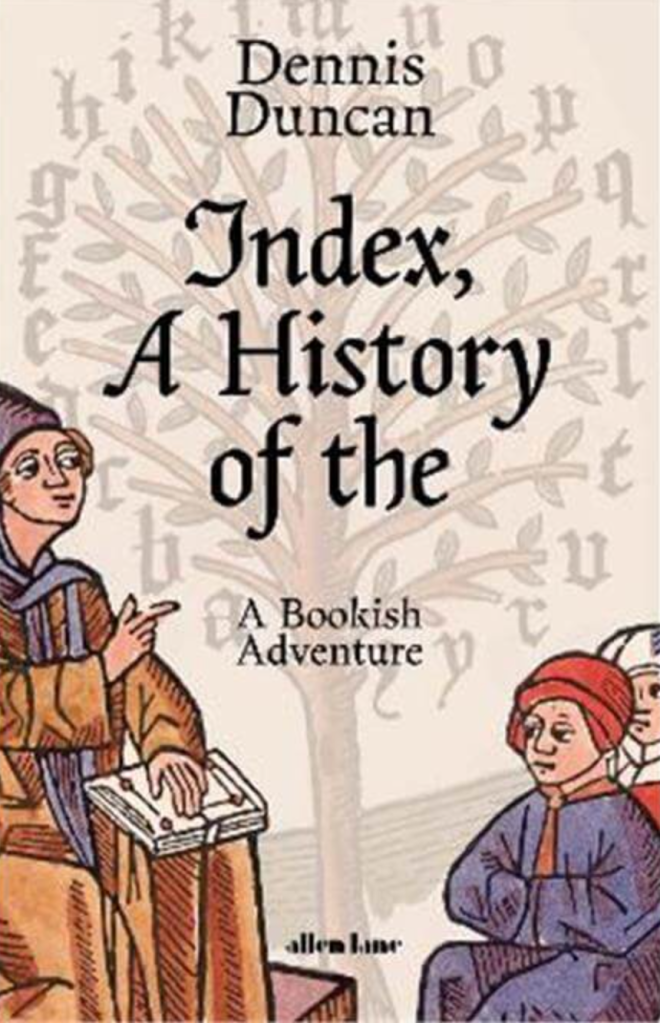In this history of indexes and indexing, Dennis Duncan offers a scholarly, but very readable, mix of information history, literature, information science, and the history of books and reading. To someone, like myself, whose ideas of indexes has revolved around the likes of Index Medicus and Chemical Abstracts, the ideas of satirical indexes, indexes as fiction, and indexes as political debate, are quite new.
Throughout the book, there is a focus on the two alternatives of concept-based subject indexing [subjective, humanistic, deep reading] and word-based concordance [objective, algorithmic, surface reading], established in the thirteenth century, and the “uncanny valley” between the two. The index has a personality, the concordance does not. While the subject index dominated most of the history of indexing, the 21st century age of search is the age of the automated concordance.
As several reviewers have pointed out, even those familiar with information history, indexes, and indexing, there are new insights to be found in this book. For me, there is inter alia an unusually clear account of Calimachus and the Pinakes in the Library of Alexandria, and a new identification of the 13th century high middle ages as an “information revolution”, with an interesting account of Grossteste and his Tables (“Google on parchment”). Then there are “a whole family of reading tools that arrived in a hurry in the few decades either side of the beginning of the thirteenth century”: tables of contents, indexes, concordances. We had to wait for the fifteenth century introduction of page numbers, dependent on printing and numerous identical copies, for these to be fully effective; before that, indexes pointed to sections or parts of a work. Ironically, e-readers, with their flow of text and their ability to change font size, have removed this fixity. and hence they rely more on search.
There is interesting coverage of Conrad Gessner’s indexes, and his praise for the index as an innovation second only to printing. His criticism of those who relied on the index rather than reading the whole, and later later condemnation of “index learning”, resonates with today’s criticism of skim reading, tldr summaries, and the digital humanities practice of distant reading. Similarly, current concerns about search engines promoting and demoting material in their ranking for nefarious purposes are reflections of Thomas Macaulay’s plea “Let no damned Tory index my History“. Indeed, a consistent theme of the book is summed up by Duncan’s assertion that “it is good for the nerves, I think, to have some historical perspective”. Early printed books were designed to look as much as possible like handwritten manuscripts, some of which alsp had indexes.
Coming nearer to the present day, there is an account of the little known nineteenth century approaches of Cross and Poole to the universal index, and the assertion that it is “no surprise that Sherlock Holmes should be an indexer”. The first attempts at computerised indexing, through the work of Artandi and Borko, are covered, and the story is brought up to date with computer-aided indexing, folksonomies, tagging and active indexes. Indexers, Duncan tells us, are ‘patient and bookish’, taggers are ‘capricious, sarcastic, and fluent in the ever-shifting inflection of the new media’. The book makes its point by giving us two indexes for its content, automated and intellectual; the comparison is, as the author says, stark.
Although the main content of the book is historical and literary, we are also given insight good on the practical issues of indexing, and how they are affected by technology, and on overlooked but important points such as word-by-word vs letter-by-letter indexing.
This book sits well alongside Ann Blair’s Too much to know as a scholarly account of how aspects of out information environment, and, giving insight into much beyond the specifics of indexing, will be worth the attention of anyone interested in information history.

